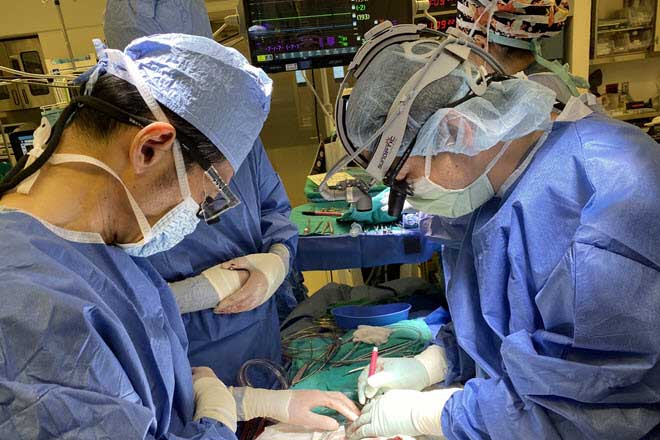Repairing Children’s Heart Valves With Patients’ Own Tissues at Stanford Medicine Children's Health
For release: December 4, 2019

Katsuhide Maeda, MD, pictured right, Shigeo Ozaki, MD, on the left
Cardiac surgeons introduce the Ozaki procedure for pediatric patients.
STANFORD, Calif. — On Nov. 22, cardiothoracic surgeons at Lucile Packard Children’s Hospital Stanford began offering an innovative repair for children’s heart valves.
The method, called the Ozaki procedure, involves crafting a new heart valve from the patient’s tissues, an improvement over implanting artificial heart valves made of metal, or bioprosthetic valves made from the tissue of cows or pigs.
“The main advantage of this procedure is that we don’t have to use a foreign-body material,” said pediatric cardiothoracic surgeon Katsuhide Maeda, MD, surgical director of the Pediatric Heart and Lung Transplant program at Packard Children’s.
Additionally, patients who receive artificial or bioprosthetic valves must take strong anticoagulants to prevent blood clots, but clots are less likely to form on patients’ own tissue, explained Shigeo Ozaki, MD, professor of cardiothoracic surgery at Toho University’s Ohashi Medical Center in Tokyo. “Using the patient’s own tissue means it’s not necessary to give strong anticoagulation therapy after the surgery, just aspirin for brief period of time,” he said. This technique also does not disrupt valve annulus (the base of the valve) itself, which implies growth potential and longer durability.
Maeda and Ozaki worked together to perform two Ozaki procedures at Packard Children’s on Nov. 22. Since developing the technique that bears his name in 2007, Ozaki has taught it to dozens of surgeons around the world. However, only a small number of hospitals in the western half of the United States offer the surgery to pediatric patients.
Hearts overtaxed
The Ozaki procedure repairs the aortic valve, located at the exit from the left ventricle, the heart’s largest pumping chamber. In a healthy heart, the valve’s three flaps open wide when the ventricles contract, allowing blood to be pushed forward into the aorta, and from there to the rest of the body. When the ventricles relax, the aortic valve closes tightly, keeping blood from backwashing into the heart.
But things can go wrong: In aortic valve stenosis, the area around the valve narrows, and the valve opens only partway. In aortic valve regurgitation, the valve leaks, and blood flows backward into the heart. Both problems make the heart work too hard, causing such symptoms as fatigue, chest pain, and shortness of breath. In children, aortic valve stenosis also slows growth.
Creating a new valve
To repair these defects with the Ozaki procedure, the surgeon cuts a piece from the pericardium, the fibrous membrane surrounding the patient’s heart. The diseased aortic valve leaflets are removed. The surgical team takes precise measurements of the aortic opening. Then, they cut and create three leaflets for a new heart valve from the pericardium. (The pericardium, which is sometimes removed for other reasons, is not essential for heart function.)
The new leaflets made from the patient’s pericardium are carefully stitched into place. The whole surgery takes around four hours, and patients are able to eat and begin walking around the next day.
Just as they outgrow T-shirts and shoes, children who receive an artificial heart valve can outgrow the valve as their body gets bigger. Although the leaflets of an aortic valve constructed via the Ozaki procedure will not grow, the way that they are sewn into place allows for continued growth and motion of the base of the aorta, the region of the blood vessel that connects to the heart. This means that after an Ozaki procedure, the blood flow through the aorta is more normal than in a patient with an artificial valve. Surgeons think this may also help the repair to last longer than conventional options.
“At Packard Children’s, we keep challenging ourselves to innovate and bring the best treatment options to our patients,” Maeda said. “The introduction of the Ozaki procedure fits perfectly into our goal of providing the very best pediatric cardiothoracic surgery available anywhere.”
Media Contact:
Samantha Beal
sbeal@stanfordchildrens.org
(650) 498-7056
About Stanford Medicine Children's Health
Stanford Medicine Children’s Health, with Lucile Packard Children’s Hospital Stanford at its center, is the Bay Area’s largest health care system exclusively dedicated to children and expectant mothers. Our network of care includes more than 65 locations across Northern California and more than 85 locations in the U.S. Western region. Along with Stanford Health Care and the Stanford School of Medicine, we are part of Stanford Medicine, an ecosystem harnessing the potential of biomedicine through collaborative research, education, and clinical care to improve health outcomes around the world. We are a nonprofit organization committed to supporting the community through meaningful outreach programs and services and providing necessary medical care to families, regardless of their ability to pay. Discover more at stanfordchildrens.org.
Connect with us:
Download our App: